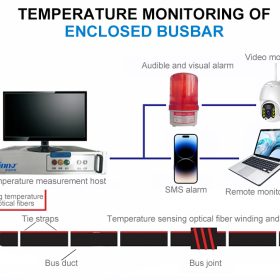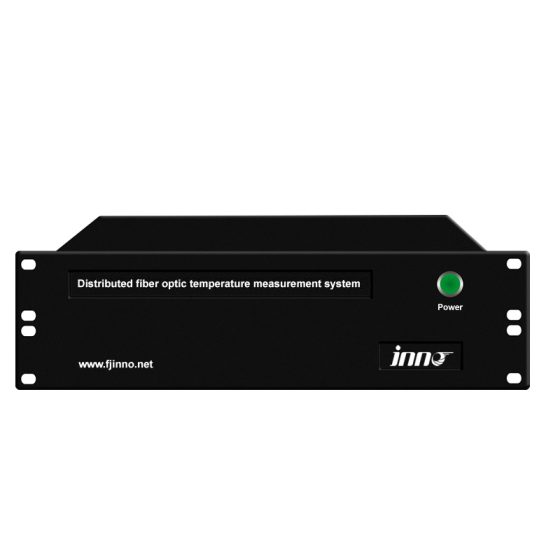เหตุใดท่อบัสจึงต้องวัดอุณหภูมิ
รางเดินสายไฟบัสบาร์แบบปิด (ย่อมาจาก Busbar Trunking) ใช้กันอย่างแพร่หลายในระบบจ่ายไฟของอาคารสูงและอาคาร. แต่ด้วยการใช้ไฟฟ้าที่เพิ่มขึ้นอย่างรวดเร็ว, ความร้อนของท่อบัสนั้นรุนแรงเป็นพิเศษ, โดยเฉพาะที่หัวเชื่อมต่อ, ซึ่งส่งผลกระทบอย่างร้ายแรงต่อการทํางานปกติของท่อบัสและต้องมีการตรวจสอบความปลอดภัยทางไฟฟ้าแบบเรียลไทม์. สายตรวจจับอุณหภูมิแบบดั้งเดิมมีข้อบกพร่องร้ายแรงในการตั้งค่า, การหาปริมาณ, ตำแหน่ง, และการนําจุดเตือนอุณหภูมิกลับมาใช้ใหม่, ซึ่งไม่สามารถตอบสนองความต้องการของการจัดการกระบวนการผลิตได้. อย่างไรก็ตาม, เทอร์โมมิเตอร์หรือเทอร์โมคัปเปิลชนิดจุดที่มีความแม่นยําสูงไม่สามารถแก้ปัญหาความต้องการของการตรวจสอบเชิงเส้นและต่อเนื่องได้.
What are the advantages of ไฟเบอร์ออปติกแบบกระจาย temperature measurement systems
พื้นที่ distributed fiber optic temperature monitoring system adopts a brand new design, ด้วยตัวบ่งชี้ประสิทธิภาพที่ดีและความเสถียรของระบบ. ระบบนี้ได้รับการพัฒนาตามหลักการของการกระเจิงรามันย้อนกลับและการสะท้อนโดเมนเวลาแบบออปติคัล (โอทีดีอาร์) ตำแหน่ง, และมีฟังก์ชั่นเช่นการสร้างสัญญาณออปติคัล, การวิเคราะห์สเปกตรัม, การแปลงโฟโตอิเล็กทริก, การขยายสัญญาณ, และการแปรรูป. ระบบใช้สายเคเบิลออปติคัลตรวจจับอุณหภูมิเฉพาะเป็นเซ็นเซอร์อุณหภูมิ, การรวมคอมพิวเตอร์, การสื่อสารด้วยไฟเบอร์ออปติก, การตรวจจับไฟเบอร์ออปติก, การควบคุมออปโตอิเล็กทรอนิกส์และเทคโนโลยีอื่น ๆ. มีความปลอดภัยโดยธรรมชาติ, ความต้านทานการกัดกร่อน, และไม่ได้รับผลกระทบจากการรบกวนทางแม่เหล็กไฟฟ้า. ตรวจสอบข้อมูลอุณหภูมิสิ่งแวดล้อมทางไกลและขนาดใหญ่อย่างต่อเนื่อง.

ลักษณะของระบบตรวจสอบอุณหภูมิช่องไฟเบอร์ออปติกแบบกระจาย
การใช้อุปกรณ์ตรวจจับอุณหภูมิไฟเบอร์ออปติกแบบกระจายเพื่อตรวจจับอุณหภูมิสายเคเบิลและข้อมูลตําแหน่งสําหรับการตรวจจับและส่งสัญญาณ, ไม่มีการตรวจจับไฟฟ้าและความปลอดภัยที่แท้จริงป้องกันการระเบิด;
ใช้การตรวจจับอุณหภูมิไฟเบอร์ออปติกแบบกระจายขั้นสูงเป็นหน่วยวัด, ด้วยเทคโนโลยีขั้นสูงและความแม่นยําในการวัดสูง:
สายเคเบิลออปติคัลตรวจจับอุณหภูมิแบบกระจายมีช่วงอุณหภูมิในการทํางานระยะยาว -40 °C ถึง 150 องศาเซลเซียส, ด้วยสูงสุด 200 องศาเซลเซียส, และการใช้งานที่หลากหลาย;
การใช้วิธีการวัดแบบลูปเดียวของเครื่องตรวจจับ, ติดตั้งง่ายและต้นทุนต่ํา; สามารถสํารองแกนสํารองได้;
แสดงอุณหภูมิแบบเรียลไทม์ในโซนต่างๆ, และความสามารถในการแสดงข้อมูลในอดีตและเส้นโค้งการเปลี่ยนแปลง, เช่นเดียวกับการเปลี่ยนแปลงอุณหภูมิเฉลี่ย:
ระบบมีโครงสร้างที่กะทัดรัด, ติดตั้งง่าย, และการบํารุงรักษาที่สะดวก;
ผ่านซอฟต์แวร์, สามารถตั้งค่าคําเตือนและสัญญาณเตือนที่แตกต่างกันได้ตามสถานการณ์จริง; วิธีการเตือนภัยมีหลากหลาย, รวมถึงสัญญาณเตือนอุณหภูมิคงที่, สัญญาณเตือนอัตราการเพิ่มขึ้นของอุณหภูมิ, และสัญญาณเตือนความแตกต่างของอุณหภูมิ.
ผ่านซอฟต์แวร์, สามารถสอบถามข้อมูลได้: แบบสอบถามแบบจุดต่อจุด, การสืบค้นบันทึกการเตือนภัย, การสอบถามช่วงเวลา, การสืบค้นข้อมูลย้อนหลัง, และการพิมพ์รายงาน.
แผนผังการติดตั้งในสถานที่ของท่อบัสไฟเบอร์ออปติกแบบกระจาย
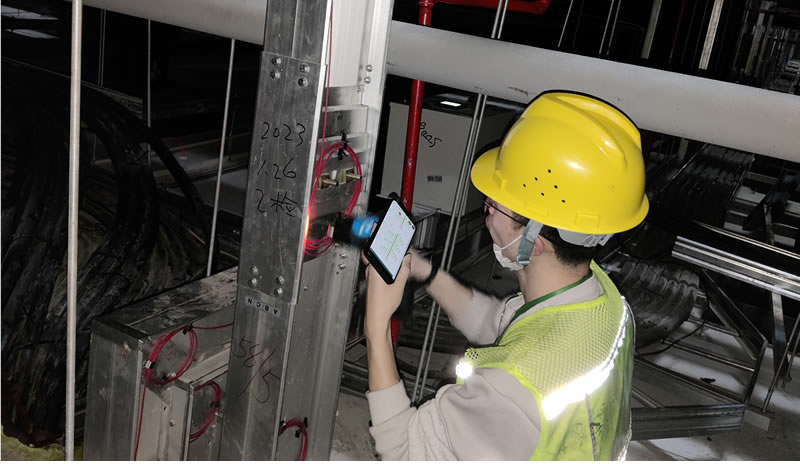 |
 |
 |
อินเทอร์เฟซซอฟต์แวร์วัดอุณหภูมิไฟเบอร์ออปติกแบบกระจาย
จัดเตรียมซอฟต์แวร์แอปพลิเคชันการตรวจสอบอุณหภูมิไฟเบอร์ออปติกที่ใช้งานง่ายและใช้งานง่าย. ซอฟต์แวร์ส่วนใหญ่ประกอบด้วยโมดูลการทํางานเช่นการตรวจสอบอุณหภูมิ, สัญญาณเตือนไฟไหม้, และการแสดงภาพ.
การแสดงเส้นโค้งอุณหภูมิ
ระบบสามารถแสดงเส้นโค้งการกระจายอุณหภูมิแบบเรียลไทม์ของสายเคเบิลออปติคัลทั้งหมด, และเมื่อมีอุณหภูมิผิดปกติในบางสถานที่, เส้นโค้งสามารถแสดงว่าอุณหภูมิ ณ ตําแหน่งนั้นเพิ่มขึ้นหรือลดลง.
สถิติอุณหภูมิย้อนหลัง
จัดเตรียมฟังก์ชันการวิเคราะห์ทางสถิติข้อมูลอุณหภูมิในอดีต, ให้แนวโน้มการเปลี่ยนแปลงของอุณหภูมิ, รวมถึง:
(1) เส้นโค้งการกระจายอุณหภูมิที่ตําแหน่งต่างๆ ของสายเคเบิลในช่วงเวลาหนึ่ง;
(2) เส้นโค้งการเปลี่ยนแปลงอุณหภูมิของสายเคเบิล ณ จุดหนึ่งในวันหนึ่ง;
(3) เส้นโค้งการเปลี่ยนแปลงอุณหภูมิ ณ จุดหนึ่งของสายเคเบิลในช่วงเวลาหนึ่ง;
(4) เส้นโค้งของการเปลี่ยนแปลงอุณหภูมิสูงสุดในวันใดวันหนึ่ง.
สัญญาณเตือนอุณหภูมิเกิน
จัดเตรียมวิธีการเตือนอัคคีภัยที่ยืดหยุ่นต่างๆ เช่น อุณหภูมิคงที่, อุณหภูมิที่เพิ่มขึ้น, และความแตกต่างของอุณหภูมิในภูมิภาค, และพารามิเตอร์การเตือนสามารถให้คะแนนและตั้งค่าตามภูมิภาคได้. เมื่ออุณหภูมิที่วัดได้เกินอุณหภูมิเกณฑ์, ระบบจะส่งสัญญาณเตือนโดยอัตโนมัติ เช่น เสียง, ไฟแสดงสถานะ LED, ข้อความ, และรูปภาพ. หากสัญญาณเตือนอุณหภูมิหลายระดับ (เช่นการเตือนครั้งแรกที่ 30 องศาเซลเซียส, ปลุกล่วงหน้าที่ 40 องศาเซลเซียส, และมาตรการที่ 50 องศาเซลเซียส) และสามารถตั้งค่าอัตราการเพิ่มขึ้นของอุณหภูมิได้, การแก้ไขอุณหภูมิสามารถทําได้ตามสภาพแวดล้อมที่แตกต่างกัน. ค่าที่ตั้งไว้ของอัตราการเพิ่มขึ้นของอุณหภูมิสามารถกําหนดได้โดยการตรวจสอบในสถานที่.
อินเทอร์เฟซภาพ
จัดเตรียมอินเทอร์เฟซการแสดงผลภาพที่แมปตําแหน่งไฟเบอร์ออปติกกับภาพผ่านโมดูลการกําหนดค่าแบบกราฟิก. เมื่อความผิดปกติของอุณหภูมิเกิดขึ้น ณ จุดหนึ่งของไฟเบอร์ออปติก, ข้อมูลการเตือนจะแสดงโดยตรงบนภาพ, ทําให้ดึงดูดสายตา.
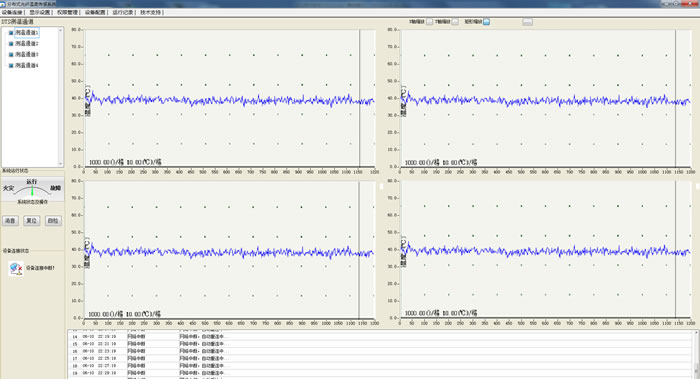 |
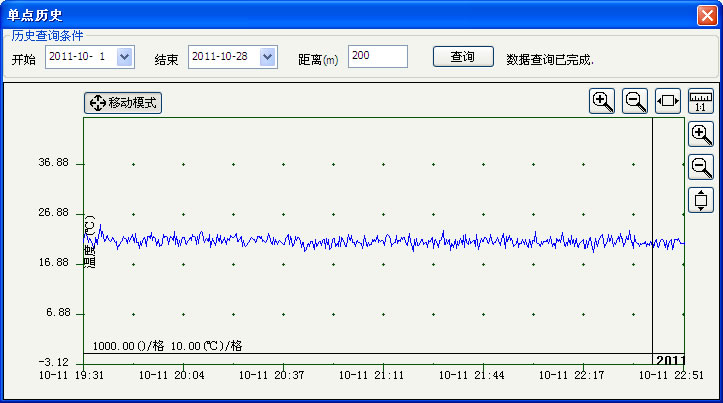 |
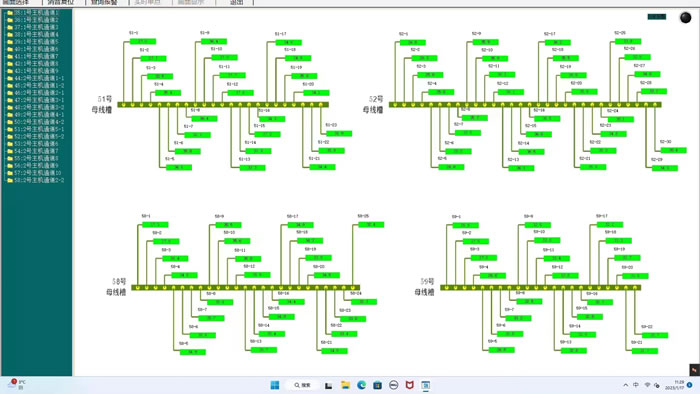 |
 เซ็นเซอร์อุณหภูมิไฟเบอร์ออปติก INNO ,ระบบตรวจสอบอุณหภูมิ.
เซ็นเซอร์อุณหภูมิไฟเบอร์ออปติก INNO ,ระบบตรวจสอบอุณหภูมิ.


